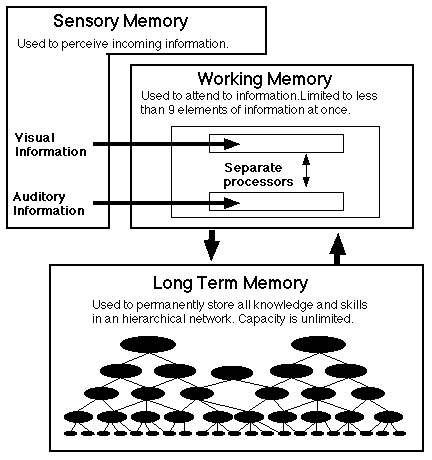- History of Learning Theories
- Learning Theories in Practice
- Behaviorism
- Humanism
- Cognitivism
- Constructivism
Cognitivism and Information Processing
A case: Teacher C (Clark)
Figure 1. Source: http://media.web.britannica.com/eb-media/03/79403-004-E9D95E8E.jpg
Different from teacher B(Ben) who cares much of students feelings and needs, Clark pays lots of attention to students thinking and knowledge acquisition. In order to make students remember and understand what need to be learned, he prepares learning material that is organized from simple to complex, and uses multimedia to present to students in a neat and coherent way. He also gives real-life examples to explain the theories, so that students can have a clear understanding.
In contrast with behaviorism, cognitive conceptions of learning:
- are less concerned with external conditions;
- focus more on internal (mental) processes in which people (Mayer, 1996) select and attend to features of the environment;
- claim that students transform and rehearse information;
- claim that students need to relate new information to previously acquired knowledge;
- and claim that students need to organize knowledge to make it meaningful.
Learning is therefore represented mentally and analogous to computer processing. Cognitive psychology has influenced learning theory and research in several significant ways, including (Shuell, 1986, p. 415):
- the view of learning as an active, constructive process;
- the presence of higher-level processes in learning;
- the cumulative nature of learning and the corresponding role played by prior knowledge;
- concern for the way knowledge is represented and organized in memory;
- concern for analyzing learning tasks and performance in terms of the cognitive processes that are involved.
Primary Theorist
John Sweller

Figure 2.John Sweller. Source: http://www.fivestepstoconquer.com/sweller_files/johnsweller—version-3.jpg
John Sweller is best known for formulating the influential theory of cognitive load that starts from the idea that working memory is limited with respect to the amount of information it can hold, and the number of operations it can perform on that information.
He studies cognitive processes and instructional design with specific emphasis on working memory limitations and their consequences for instructional procedures. Hence, the key aspect of the theory is the relation between long-term memory and working memory, and how do we develop quality instruction to help optimize the working memory.
Cognitive Load Theory
Definition
Cognitive load theory suggests that learning happens best under conditions that are aligned with human cognitive architecture. Human cognitive architecture met this requirement by its combination of working and long-term memory.
- Long term memory effectively stores all of our knowledge and skills on a more-or-less permanent basis
- Long-term memory provides humans with the ability to vastly expand this processing ability. This memory store can contain vast numbers of schemascognitive constructs that incorporate multiple elements of information into a single element with a specific function.
- Information may only be stored in long term memory after first being attended to, and processed by working memory.
- Working memory (short term memory) is extremely limited in both capacity and duration. Only a limited amount of information can be held in WM, transferred to LTM, rehearsed, and so forth
Based on a cognitive architecture that consists of a limited working memory with partly independent processing units for visual and auditory information, which interacts with an unlimited long-term memory, cognitive load theory is concerned with techniques for reducing working memory load in order to facilitate the changes in long term memory associated with schema acquisition.

Figure 3. The mechanism of memory. Source: http://dwb4.unl.edu/Diss/Cooper/UNSW_files/CLT_NET_Aug_97_HTML6.gif
Basic Assumptions and Principles
Sweller differentiates between intrinsic, germane, and extraneous cognitive load.
- Intrinsic cognitive load depends on the unalterable properties of the information to be learned and is eased only when learners acquire an effective cognitive schema to deal with the information.
- Extrinsic cognitive load is caused by the manner in which the material is presented or the activities required of the learner
- Germane load (relevant) relates to the degree of effort involved in the processing, construction and automation of schemas and it is sometimes associated with motivation and interest.
Classroom Implications and Teaching Strategies
How the material is taught influences the extrinsic cognitive load. Teachers who give clear presentations help to minimize extrinsic cognitive load, whereas those who explain these concepts poorly increase extrinsic load (Schunk, 2012)
- A key idea is that instructional methods should decrease extraneous cognitive load so that existing resources can be devoted to learning. The use of scaffolding should be beneficial to minimize the extrinsic load so learners can focus their resources on the intrinsic demands of the learning. As learners develop a schema to work with the information, the scaffold assistance can be phased out.
- Another suggestion is to use simple-to-complex sequencing of material. Dividing complex learning into simple parts that are acquired and combined into a larger sequence minimizes cognitive load, so learners can focus their cognitive resources on the learning at hand.
- A third suggestion is to use authentic tasks in instruction. Tasks that have real-world significance help to minimize extrinsic load because they do not require learners to engage in extraneous processing to understand the context.
Resources
Key Works
- Chandler, P., & Sweller, J. (1991). Cognitive load theory and the format of instruction. Cognition and instruction, 8(4), 293-332.
- Sweller, J., Ayres, P., & Kalyuga, S. (2011). Cognitive load theory (Vol. 1). Springer.
- Paas, F., Renkl, A., & Sweller, J. (2003). Cognitive load theory and instructional design: Recent developments. Educational psychologist, 38(1), 1-4.
- Van Merrienboer, J. J., & Sweller, J. (2005). Cognitive load theory and complex learning: Recent developments and future directions. Educational psychology review, 17(2), 147-177.
Successful Examples
- Introduction to Cognitive Load Theory
According to Schunk (2012), information processing is not the name of a single theory. Rather, it is a generic name applied to theoretical perspectives dealing with the sequence and execution of cognitive events. The pages below describe some specific instructional approaches and strategies such as:
References
- Mayer, R. E. (1996). Learners as information processors: Legacies and limitations of educational psychology’s second.. Educational psychologist,31(3-4), 151-161.
- Shuell, T. J. (1986). Cognitive conceptions of learning. Review of educational research, 56(4), 411-436.
- Schunk, D. H. (2012) Learning theories: An educational perspective. New York, NY, England: Macmillan Publishing Co, Inc.
